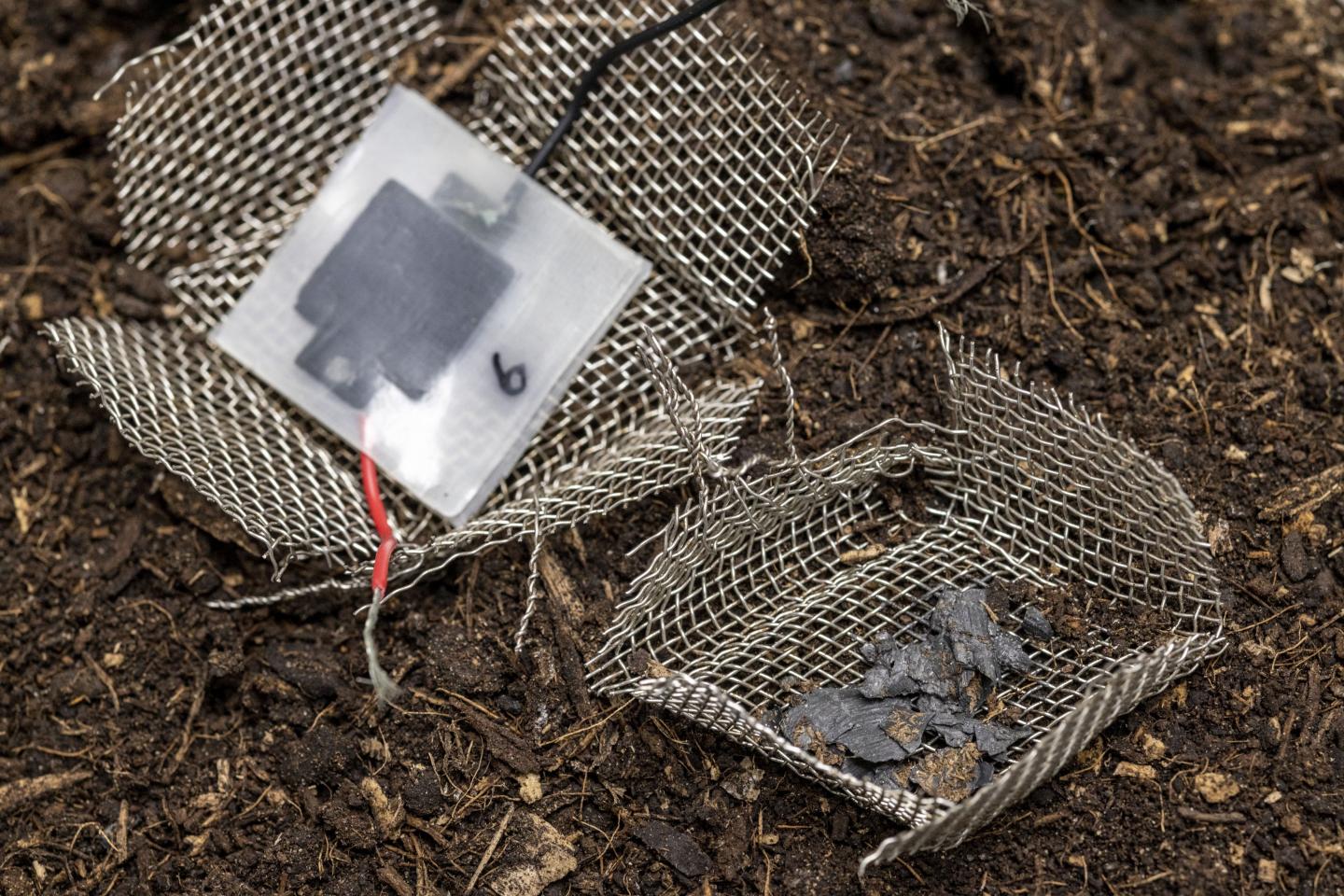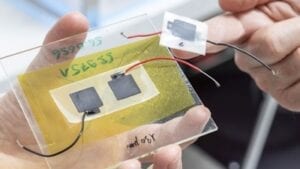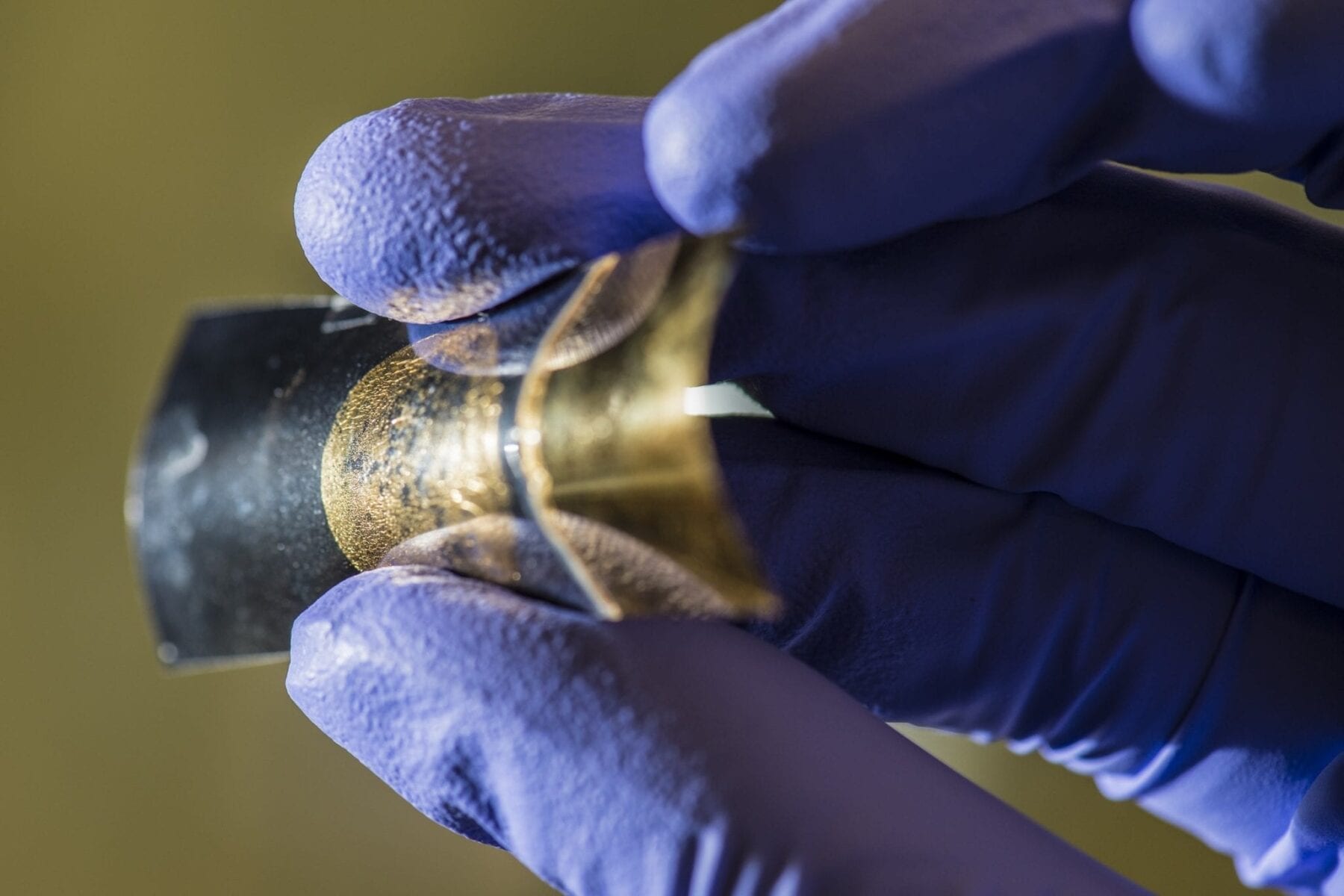
After two months buried in the soil, the capacitor has disintegrated, leaving only a few visible carbon particles.
The number of data-transmitting microdevices, for instance in packaging and transport logistics, will increase sharply in the coming years. All these devices need energy, but the amount of batteries would have a major impact on the environment. Empa researchers have developed a biodegradable mini-capacitor that can solve the problem. It consists of carbon, cellulose, glycerin and table salt. And it works reliably.
The fabrication device for the battery revolution looks quite unconspicuous: It is a modified, commercially available 3D printer, located in a room in the Empa laboratory building. But the real innovation lies within the recipe for the gelatinous inks this printer can dispense onto a surface. The mixture in question consists of cellulose nanofibers and cellulose nanocrystallites, plus carbon in the form of carbon black, graphite and activated carbon. To liquefy all this, the researchers use glycerin, water and two different types of alcohol. Plus a pinch of table salt for ionic conductivity.

To build a functioning supercapacitor from these ingredients, four layers are needed, all flowing out of the 3D printer one after the other: a flexible substrate, a conductive layer, the electrode and finally the electrolyte. The whole thing is then folded up like a sandwich, with the electrolyte in the center.
What emerges is an ecological miracle. The mini-capacitor from the lab can store electricity for hours and can already power a small digital clock. It can withstand thousands of charge and discharge cycles and years of storage, even in freezing temperatures, and is resistant to pressure and shock.
Biodegradable power supply
Best of all, though, when you no longer need it, you could toss it in the compost or simply leave it in nature. After two months, the capacitor will have disintegrated, leaving only a few visible carbon particles. The researchers have already tried this, too.
“It sounds quite simple, but it wasn’t at all,” says Xavier Aeby of Empa’s Cellulose & Wood Materials lab. It took an extended series of tests until all the parameters were right, until all the components flowed reliably from the printer and the capacitor worked. Says Aeby: “As researchers, we don’t want to just fiddle about, we also want to understand what’s happening inside our materials.”
Together with his supervisor, Gustav Nyström, Aeby developed and implemented the concept of a biodegradable electricity storage device. Aeby studied microsystems engineering at EPFL and came to Empa for his doctorate. Nyström and his team have been investigating functional gels based on nanocellulose for some time. The material is not only an environmentally friendly, renewable raw material, but its internal chemistry makes it extremely versatile.
“The project of a biodegradable electricity storage system has been close to my heart for a long time,” Nyström says. “We applied for Empa internal funding with our project, Printed Paper Batteries, and were able to start our activities with this funding. Now we have achieved our first goal.”
Application in the Internet of Things
The supercapacitor could soon become a key component for the Internet of Things, Nyström and Aeby expect. “In the future, such capacitors could be briefly charged using an electromagnetic field, for example, then they could provide power for a sensor or a microtransmitter for hours.” This could be used, for instance, to check the contents of individual packages during shipping. Powering sensors in environmental monitoring or agriculture is also conceivable – there’s no need to collect these batteries again, as they could be left in nature to degrade.
The number of electronic microdevices will also be increasing due to a much more widespread use of near-patient laboratory diagnostics (“point of care testing”), which is currently booming. Small test devices for use at the bedside or self-testing devices for diabetics are among them. “A disposable cellulose capacitor could also be well suited for these applications”, says Gustav Nyström.
Original Article: The biodegradable battery
More from: Swiss Federal Laboratories for Materials Science and Technology
The Latest Updates from Bing News & Google News
Go deeper with Bing News on:
Biodegradable battery
- The Verge’s 2024 Mother’s Day gift guide
There’s never a bad time to show appreciation for your mom, but Mother’s Day serves as an opportunity to go above and beyond for the person who birthed, bathed, and burped you. For many, brunch and ...
- The 2024 Popular Mechanics Yard & Garden Awards
At Popular Mechanics, this is the season we test the latest products for our annual Yard & Garden Awards. We roll up our sleeves (well, assuming it’s warm enough to roll them up) and have at the ...
- To all waste pickers, thank you for your service
She is a familiar figure in our street. Weather beaten and stocky, she could be mistaken for a man at first sight. Her name is Bilot, short for Violeta. Once every week, undeterred by the heat of the ...
- Asahi Kasei to Construct a Lithium-ion Battery Separator Plant in Canada
Its Material sector, comprised of Environmental Solutions, Mobility & Industrial, and Life Innovation, includes a wide array of products from battery separators and biodegradable textiles to ...
- CCELL Celebrates Earth Day with a Sustainable Solution for Disposable Vapes--Biodegradable and Recyclable Components
Created from biodegradable, plant-based PLA and designed with an easily removable battery, the Eco Star empowers consumers to make more eco-conscious choices when enjoying the convenience of an AIO ...
Go deeper with Google Headlines on:
Biodegradable battery
[google_news title=”” keyword=”biodegradable battery” num_posts=”5″ blurb_length=”0″ show_thumb=”left”]
Go deeper with Bing News on:
Biodegradable mini-capacitor
- NYT Mini Crossword today: puzzle answers for Thursday, April 25
That’s what The Mini is for! A bite-sized version of the New York Times’ well-known crossword puzzle, The Mini is a quick and easy way to test your crossword skills daily in a lot less time ...
- Do You Really Need Compostable Bags for Your Food Scraps?
Updated April 12, 2024 Rose Maura Lorre Share this post If you save food scraps for composting, lining your kitchen collection bin with a bag labeled as compostable or biodegradable may seem like ...
- The Best Windows Mini PCs for 2024
Why We Picked It This is a mini PC fit for a home office, secondary workspace, or small business, and the configuration we reviewed ensures any of those users can get real work done. This compact ...
- The Best Mini Keyboards for Gaming in 2024
Mini keyboards are becoming the most popular choice lately, so which ones are the best? The best gaming keyboards come in all sorts of shapes and sizes. Lately, the trend has leaned towards gamers ...
- How The Flux Capacitor Works In Back To The Future
It was a fateful day for Doc Brown in 1955 when he fell off his toilet, hit his head on his sink, and woke up with the image of the flux capacitor burning into his brain. That was the moment that ...
Go deeper with Google Headlines on:
Biodegradable mini-capacitor
[google_news title=”” keyword=”biodegradable mini-capacitor” num_posts=”5″ blurb_length=”0″ show_thumb=”left”]










